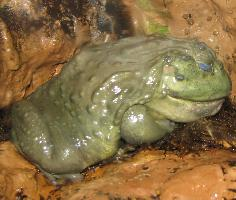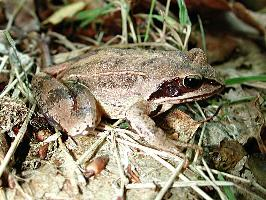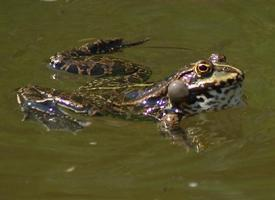
Súlyok és méretek
| Hossz | 6-tól 8-ig cm |
|---|
Biológiai adatok
| Élettartam | 8-tól 12-ig éves |
|---|
Állatleírás
The Moor Frog (Rana arvalis) is a fascinating amphibian species belonging to the Ranidae family, widely recognized for its remarkable adaptive features and unique breeding behaviors. This species is primarily found across Europe and parts of Asia, thriving in a variety of habitats that include forests, meadows, marshes, and agricultural lands, provided these areas have access to suitable aquatic environments for breeding.Characterized by its modest size, the Moor Frog typically reaches lengths of up to 7 centimeters, with males usually being slightly smaller than females. Their skin color can vary significantly depending on environmental factors and physiological conditions, ranging from brown, gray, and olive green to more vivid shades. One of the most striking features of the Moor Frog, particularly noticeable in males during the breeding season, is the temporary transformation of their skin color to a bright blue. This color change, lasting only a few days, is believed to attract females and is a spectacular natural phenomenon that draws interest from nature enthusiasts and researchers alike.
The Moor Frog's diet primarily consists of insects, spiders, and other small invertebrates, making it an integral part of the food web in its ecosystem. It employs a sit-and-wait strategy for hunting, where it remains motionless and waits for prey to come within striking distance.
Reproduction in Moor Frogs takes place in early spring, with the timing heavily influenced by the temperature and availability of suitable aquatic environments. Females lay thousands of eggs in clusters, which are then fertilized externally by the males. These eggs are often laid in temporary bodies of water, such as flooded fields or ditches, which provide a safer environment for the developing larvae, free from many predators found in permanent water bodies. The tadpoles undergo a rapid development, usually metamorphosing into froglets within a few months, enabling them to leave the water before these temporary aquatic habitats dry up.
Despite their wide distribution, Moor Frog populations are facing threats from habitat destruction, pollution, and climate change. Wetland drainage for agriculture and urban development reduces available breeding sites, while water pollution and the introduction of invasive species further exacerbate the challenges to their survival. Conservation efforts are crucial to ensure the survival of this species, including the protection and restoration of wetland habitats and the implementation of sustainable land use practices.
In summary, the Moor Frog is a remarkable amphibian with unique characteristics and behaviors, playing a vital role in its ecosystem. Its adaptability to various habitats and the striking breeding coloration of males make it a subject of interest for both scientific study and conservation efforts. As with many amphibian species, the Moor Frog faces significant environmental challenges, highlighting the need for continued research and conservation actions to secure its future.
Hasonló állatok
Új állatfotók
Top 10 állat
- Dolphin gull (Leucophaeus scoresbii)
- Diana monkey (Cercopithecus diana)
- Moustached guenon (Cercopithecus cephus)
- Galápagos tortoise (Geochelone nigra complex)
- Japanese macaque (Macaca fuscata)
- Stone loach (Barbatula barbatula)
- Greek tortoise (Testudo graeca)
- Russian tortoise (Testudo horsfieldii)
- Common flying dragon (Draco volans)
- Galápagos penguin (Spheniscus mendiculus)


